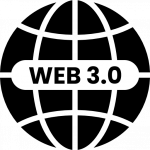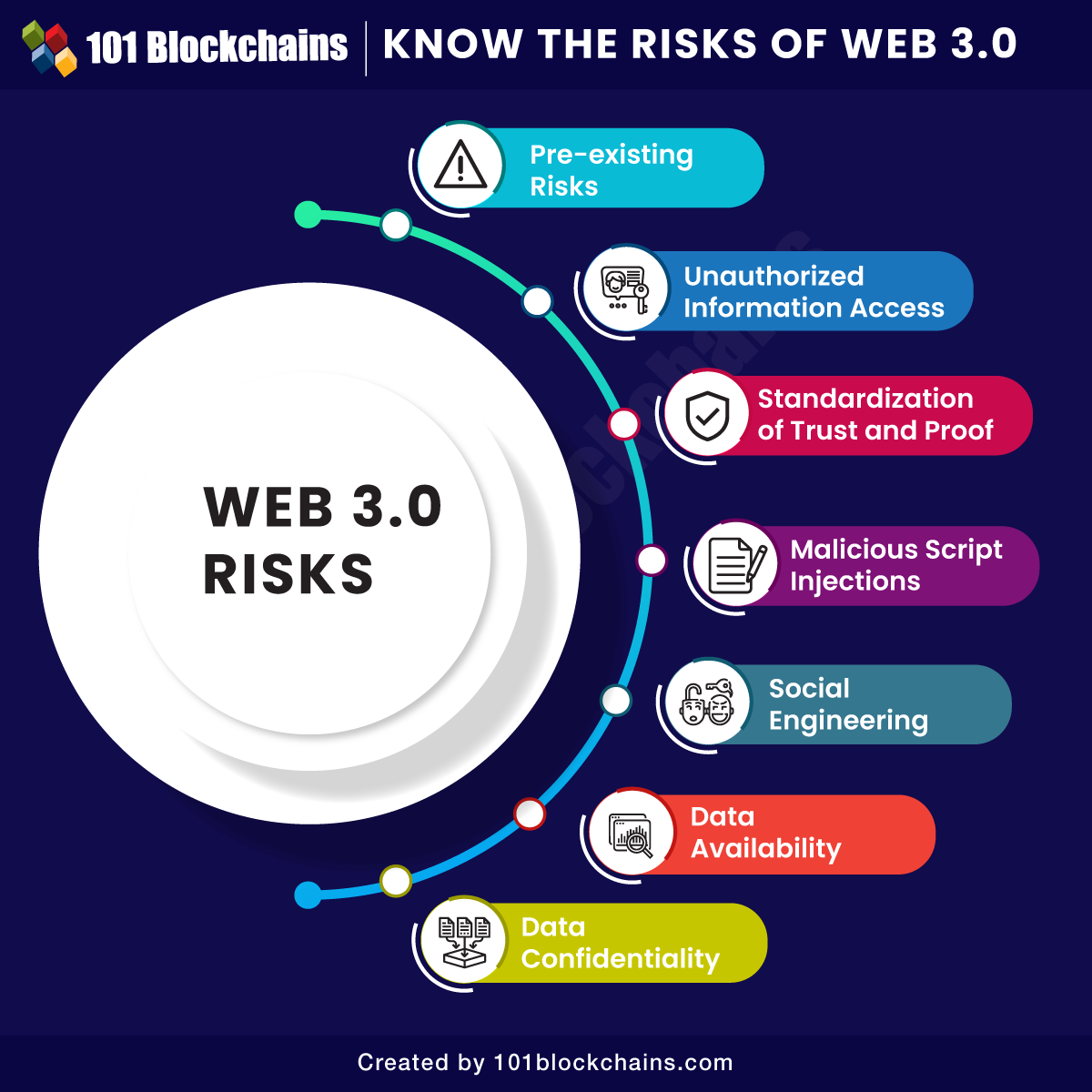Learn how blockchain truly works, master key definitions, and uncover what makes smart contracts so "smart." Dive into the fundamentals, gain valuable insights, and start your blockchain journey today!

- Web3
- By Georgia Weston
- on September 21, 2022
Know the Risks of Web 3.0
The early days of the internet had only static web pages developed by companies for serving information like important announcements. Subsequently, the world came to know social media platforms and new ways for users to contribute content to the web. However, the benefits of user-generated content did not overshadow the manipulation of user data for personal gains by centralized institutions. While web3 has the potential to resolve existing setbacks with the web, it is also important to identify web 3.0 risks and their impact on the broader web.
Web3 has the right components and implications for ensuring easier access to information and services without compromising the integrity of user data and personal information. On the other hand, concerns regarding the security risks with web3 would also take the limelight in defining the future of web3. The following discussion dives deeper into an outline of prominent security risks for web3 ecosystem.
Why Does the Web 3.0 Matter?

The discussion on web3 security must emphasize its significance. Why is web3 so important that you have to worry about risks in web3? According to the classic definitions of web3, the concept of ‘semantic web3’ provides an almost realistic explanation for how web3 would work. Semantic web basically implies that all the data on the web would be machine-readable.
The semantic metadata of a webpage provides a detailed meaning of different elements of the webpage to computers. The internet works as a massive and connected database on the basis of semantic metadata. Search queries rely on capabilities of machines for reading the semantic metadata to facilitate contextually appropriate search results with better accuracy.
The importance of web3 could shed further light on the necessity for identifying web3 security risks and their impact. In the case of web2, search engines would offer results on the basis of keywords in web content. As a result, there is no way web2 search engines would consider contextual understanding. On the contrary, web3 can help in better information analytics and transactions through a deeper contextual understanding of all pages.
Apart from the “semantic web” traits, web3 also emphasizes it distributed networking or decentralization to resolve pressing concerns with web2. Decentralization helps in preventing the unwarranted influence of big tech companies such as Google, Facebook and Twitter on access to internet services. Users have the freedom to interact with sites and apps without any permission. At the same time, web3 also allows complete control over its own data to users without any centralized intermediaries.
Curious to develop an in-depth understanding of web3 application architecture? Enroll Now in Web3 Application Development Course!
What are the Risks for Web3?
The traits of web3 paint a positive picture of what you can achieve from the new iteration of the internet. If you are wondering about possible setbacks for web3 cyber security, you must have many doubts. How is web3 vulnerable to security risks when it relies on distributed technologies such as blockchain to ensure better security? User-generated content on distributed and decentralized platforms can appear as a significant improvement over web2 applications.
On the other hand, you need to understand that anyone could have the privilege of adding content to the web. Without centralized gatekeepers, there is no specific framework for verifying information added to the web. In addition, the machine-readable content in web3 is vulnerable during transit as web3 data can be interpreted by people as well as machines.
Above everything else, the list of web3 challenges also pointed to how users have to take responsibility for security of their data. Some of the common risks for web3 include data manipulation, confidentiality of data, information quality and availability of web3 data. The assessment of the different types of risks evident within the web3 ecosystem can serve a clearer picture.

-
Pre-existing Risks
The answers to “Is web3 safe?” would generally point to the explanations for incremental evolution of security risks at the different stages in evolution of the internet. Security vulnerabilities in the first generation of the web also translated to web2, and the same notion can be applied to the third generation of the internet. Some of the common examples of web3 vulnerability one could expect with the evolution of internet include the following,
- Malicious attacks lead to loss of confidential and personal information.
- Unauthorized digital intrusion.
- Non-compliance with regulatory precedents.
- Additional dependence on third-party services.
- Application performance setbacks are owing to continuous updates.
- Limited experienced staff for efficient operation and monitoring of complicated applications and systems.
- Wasteful utilization of organizational resources.
The pre-existing risks are basically a set of mandatory challenges every organization has to encounter with web3. However, the pre-existing risks could magnify further in the web3 transformation, thereby creating critical setbacks.
-
Unauthorized Information Access
The most common examples of a web3 hack would point at possibilities for unauthorized access to confidential or sensitive information. As the internet grows with web3, the amount of data available on the web will grow by exponential margins. Web3 can personalize web user experiences, while intelligent automation in web3 could help in decoding personal information alongside browsing history to facilitate automation of the web experiences.
Therefore, web3 would introduce many privacy risks to sensitive personal information of users. At the same time, web3 security must focus on preventing unauthorized access as well as unauthorized modification and utilization of resources. What are the potential types of scenarios for unauthorized access to information? For example, entities gain unauthorized access to the system without authentication. Unauthorized access to data could also lead to concerns of unauthorized data manipulation, such as changing data during transfer across a network.
The concerns of risks due to unauthorized access to sensitive information can also include possibilities of network eavesdropping. Monitoring software for web3 applications can lead to network eavesdropping, especially with limited encryption. Message relay attacks also qualify as a notable web3 vulnerability as they involve unauthorized people intercepting the data transmitted across a network. The message relay attacks are more likely to happen in systems without ID numbers, encryption or digital signatures for messages.
-
Standardization of Trust and Proof
The web3 can capitalize on the power for harvesting and integrating data autonomously alongside converting data into productive information. Therefore, all the statements in web3 must be considered as mere claims before establishing the foundation of trust. After establishing the claims, users can place their trust in the information.
How can users trust the harvested information on web3? The analysis of the information source alongside the policies available on the information source could serve as a reasonable answer. Intelligent Assistants could deal with web3 security risks by leveraging the reputation and context of sources to determine the level of trust for a specific source.
The different Intelligent Assistants could interact with each other without human intervention to determine trustworthiness of a specific source. As a result, malicious attackers can create scripts representing a credible agent, thereby helping them carry out unauthorized transactions or add malicious scripts.
The list of web 3.0 risks would also emphasize semantic tagging, which helps scriptwriters in offering inaccurate information to improve website ranking. Malicious agents could draw unsuspecting users to websites mired with different types of dangerous scripts and malware.
Want to learn how to design and develop secure blockchain systems and distributed applications? Enroll Now in Certified Blockchain Security Expert (CBSE) Course
-
Malicious Script Injections
The overview of web3 might showcase that Solidity is the focal programming language for the web3 ecosystem. On the contrary, web3 relies on multiple levels of languages, with each level showcasing individual traits. However, web3 cyber security challenges emerge profoundly in the field of query or update languages.
The common types of web 3.0 query injections could result in major implications for web3 security. SPARQL injections help hackers in accomplishing unauthorized access to back-end layer of database. Attackers could structure specific queries for manipulating the execution of web3 application commands.
The second type of risk in script injections would refer to the Blind SPARQL injections, which query the database. Blind SPARQL injections involve repeated querying for the database, which harvests sensitive information. Another example of script injection refers to the SPARUL injections, which are basically updated variants of SPARQL injections. Malicious script injections like SPARUL injections could not only help in reading queries but also in writing them. As a result, they can open up better facilities for manipulating and extracting data from databases.
-
Social Engineering
The next big entry among discussions around “is web3 safe” would refer to social engineering attacks. Web3 would introduce semantic metadata supported by ontologies for better integration capabilities. Users can lose track of the sensitive data on the web and its storage, thereby leading to threats of inference attacks.
Hackers could employ inference attacks as an intense data mining process, which allows confidential harvesting of information alongside disclosing the same. Unauthorized parties can take up the identity of trusted third parties and harvest confidential information.
On the other hand, web3 challenges for security in social engineering would also emphasize identity theft. Identity theft basically involves personal harvesting information for fraudulent objectives of obtaining information stored across multiple electronic devices and channels. Social engineering threats have become more complicated and serious, especially considering how scriptwriters can exploit sensitive metadata information.
Get familiar with the terms related to Web 3.0 with Web 3.0 Flashcards
-
Data Availability
Data availability is another pressing concern in the list of web 3.0 risks, with almost everything going digital. Web3 participants have to worry about the necessity of depending too much on data. How is web3 supposed to work when systems and processes don’t have the required data? Many people have encountered the problem of broken links throughout web2, and the same can be expected in web3. On top of it, the vulnerability can be extremely consequential as IT teams would not have any control over web3 systems.
-
Data Confidentiality
Data breaches are one of the common issues on the web, and they can result in compromises of confidential information. You can accidentally release or place content in an insecure location. With web3, users have to worry about instances of web3 hack on the grounds of confidentiality. Systems empowered with semantic web capabilities can read data during transfer and also support easier understanding.
Therefore, interception of sensitive information through web3 can become one of the prominent security concerns for web3. As information moves around freely in web3, it becomes more vulnerable to exposure and increases the chances of spreading confidential information at faster rates.
Build your fluency in advanced technologies and develop decentralized solutions for the emerging web3 ecosystem through Web3 Expert Career Path
Final Words
The security risks associated with web3 paint a credible overview of what security experts can expect in web 3.0. Security risks are a pressing concern for adoption of web3 as new users do not want to put their valuable information at risk. Furthermore, the transition to web3 would have many formidable implications for the digital transformation of many conventional processes and everyday activities.
The emphasis on web3 security is a critical ingredient for ensuring the successful adoption of web3 in the long run. Security challenges such as unauthorized access to information and data confidentiality could affect the use of web3 technologies. On the other hand, a proactive approach to risk identification can help you achieve significant value improvements in using web3. Learn more about the risks associated with the web3 ecosystem now.
*Disclaimer: The article should not be taken as, and is not intended to provide any investment advice. Claims made in this article do not constitute investment advice and should not be taken as such. 101 Blockchains shall not be responsible for any loss sustained by any person who relies on this article. Do your own research!



